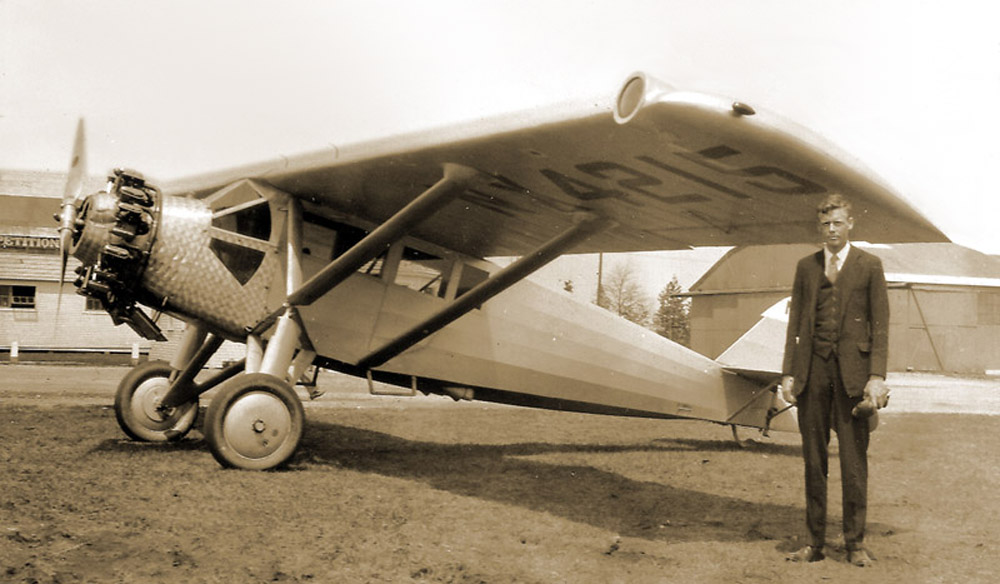 Sending mail through the air added a sense of glamor and civility to an otherwise mundane task. Peacetime uses for aircraft, such as the de Haviland Tiger Moth, inspired fascination with machines that flew in the sky.
Sending mail through the air added a sense of glamor and civility to an otherwise mundane task. Peacetime uses for aircraft, such as the de Haviland Tiger Moth, inspired fascination with machines that flew in the sky. In the immediate post-war period, several factors were working against the widespread expansion of aviation, particularly in the U.S. North America had precious few airfields in existence of under construction. Also, there was still the problem of passenger aircraft, or lack thereof.
Nonetheless, aviation, related businesses managed to develop and grow.
 From the ashes of World War I, the British flying team of John Alcock and Arthur Brown stunned the world. Aboard a converted bomber, a Vickers Vimy, the duo took off from Newfoundland and landed in Ireland less than sixteen hours later. The first non-stop transatlantic flight showed the world how the airplane could bring people and places closer to one another faster than ever before. (The Vimy, employed for use as a bomber by the British Air Force, could carry ten passengers after alterations.)
From the ashes of World War I, the British flying team of John Alcock and Arthur Brown stunned the world. Aboard a converted bomber, a Vickers Vimy, the duo took off from Newfoundland and landed in Ireland less than sixteen hours later. The first non-stop transatlantic flight showed the world how the airplane could bring people and places closer to one another faster than ever before. (The Vimy, employed for use as a bomber by the British Air Force, could carry ten passengers after alterations.) The flight nearly ended in disaster several times owing to engine trouble, fog, snow and ice. It was only saved by Brown's continual climbing out on the wings to remove ice from the engine air intakes and by Alcock's excellent piloting despite extremely poor visiblity at times and even snow filling the open cockpit.
The flight nearly ended in disaster several times owing to engine trouble, fog, snow and ice. It was only saved by Brown's continual climbing out on the wings to remove ice from the engine air intakes and by Alcock's excellent piloting despite extremely poor visiblity at times and even snow filling the open cockpit.Shortly thereafter, the first scheduled airline service was established between England and the European continent. Regular service aboard de Haviland DH-4s and DH-6s began in August 1919, linking London and Paris.
 Seating for two was offered aboard Handley Page 0/400s that had been used as bombers during World War I.
Seating for two was offered aboard Handley Page 0/400s that had been used as bombers during World War I.In the 1920s, American aviators grabbed the international spotlight with daring aerial feats.
 None were more heroic than Charles Lindbergh's solo flight across the Atlantic in 1927. Aboard a Ryan monoplane loaded with sandwiches, but without the aid of a radio or sextant, Lindbergh left a Long Island airfield on May 20. Thirty-three hours and thirty minutes later, he touched down in Le Bourget, France, the first aviator to cross the Atlantic Ocean solo.
None were more heroic than Charles Lindbergh's solo flight across the Atlantic in 1927. Aboard a Ryan monoplane loaded with sandwiches, but without the aid of a radio or sextant, Lindbergh left a Long Island airfield on May 20. Thirty-three hours and thirty minutes later, he touched down in Le Bourget, France, the first aviator to cross the Atlantic Ocean solo. In the early 1930s, Amelia Earhart took a major step forward for the suffragette movement when she piloted a Lockheed Vega from Newfoundland to Northern Ireland in May 1932.
In the early 1930s, Amelia Earhart took a major step forward for the suffragette movement when she piloted a Lockheed Vega from Newfoundland to Northern Ireland in May 1932.Three months later she crossed the continental United States from New York to Los Angeles without stopping. Both feats were firsts for women, and no doubt served to encourage young women and men to pursue the field of aviation.
The first scheduled international air service in America was founded when Aeromarine West Indies Airways began service between Key West, Florida and Havana, Cuba. Curtiss Flying Boats were used on this route, a practice that became widespread due to the lack of land-based airfields.
The Flying Boats of the 1920s fell out of favor in the late 1930s, since they were unable to reach landlocked cities, but not before some spirited production of some classic amphibious aircraft.
No comments:
Post a Comment